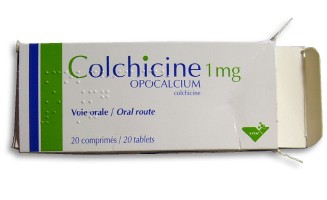Facts and pearls about some of the drugs we use frequently in the ED
Major Indications: Acute gout flares and gout prophylaxis. The new FDA-approved regimen for acute flares is 1.2mg followed by 0.6mg after 1 hour. Prophylaxis is 0.6mg daily.
In The News: After a recent study of colchicine use for gout, the FDA approved its use and granted 3-year exclusive marketing rights to the company that performed the study, leading to a huge jump in the price.
How it works: Colchicine binds to the tubulin in microtubules, inhibiting neutrophil motility and therefore reducing inflammation in gout attacks. It is also used in the lab for karyotype studies, to halt mitosis and visualize the chromosomes in different stages of cell division.
Notable History: The use of colchicine for rheumatic complaints dates back before 1500 BC. It is a natural product derived from the autumn crocus plant. Colchicine has been FDA approved for use in combination with probenicid for gout since 1982. As part of a program to promote safety studies for grandfathered meds, in 2009 the FDA approved its use for acute gout flares, gout prophylaxis, and Familial Mediterranean Fever. It is also used off-label for pseudogout, Behcet’s disease, pericarditis, and primary biliary cirrhosis.
Adverse Events: The most common are nausea, vomiting, and diarrhea. Chronic use can lead to side effects from microtubule inhibition, including neuropathy, bone marrow suppression, hair loss, and progressive proximal muscle weakness.
Cautions:
Avoid grapefruit juice, which increases the serum colchicine concentration
Pregnancy: Class C – Teratogenic in lab animals.
Lactation: There is limited data available, but it is probably best to avoid in breast-feeding mothers (Hale, T.W. Medications and Mothers’ Milk, 2012).
Dose adjustments:
For patients over 70, use half the dose for prophylaxis. Patients who are on strong CYP3A4 inhibitors (includes many HAART meds, anti-fungals, and antibiotics; common ones are atazanavir, indinavir, clarithromycin, fluconazole, ketoconazole) or P-gp inhibitors (cyclosporine) can have serious complications and should receive lower doses for acute flares. Colchicine is contra-indicated for an acute flare if any two of the following three are true:
1. The patient is on a strong CYP3A4 or P-gp inhibitor
2. The patient has renal or hepatic impairment
3. The patient takes prophylactic colchicine
(If 2 out of 3 are true, don’t use Colchicine)
Fortunately, NSAIDs, such as 50mg indomethacin three times daily, or naprosyn 500mg twice daily, have been shown to be just as effective as colchicine for treating the pain of acute gout flares and can be used instead (assuming the patient has no contraindicates to NSAIDs).
Cost: The price for colchicine rose from $0.09 to $4.85 per tablet in recent years. No generic form is currently available.



